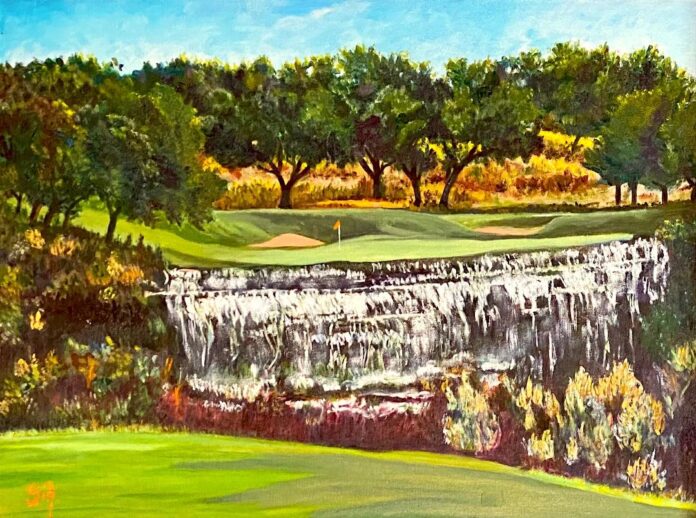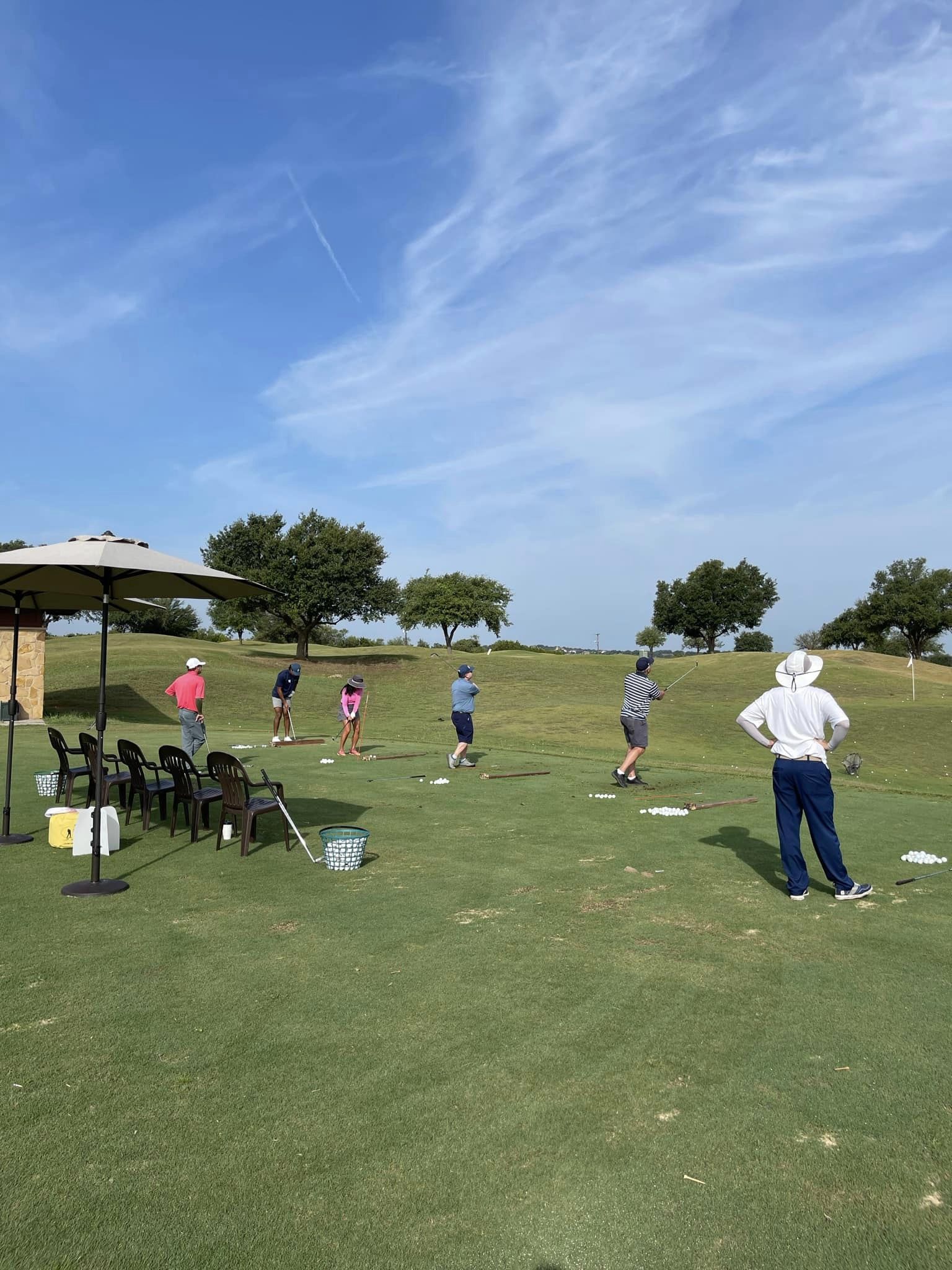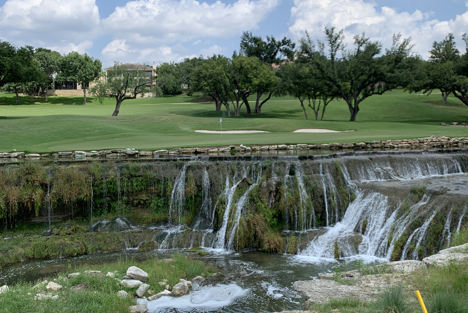
by Frank Giordano Jr.
AUSTIN, Texas – Forty years after first writing about The Hills golf course north of Austin, Texas, I recently had the privilege of visiting and playing there again. My excitement before returning there was related to my discovering back in the early 1980s what I called “the most beautiful hole in Texas.” What would have been No. 7’s fate after all these decades and the inevitable changes wrought by the region’s history of droughts and damaging winds, and the necessary adjustments and refurbishing a Jack Nicklaus Signature course receives bi-annually through the decades? And not insignificantly, what features did I miss about the course’s design and natural terrain as a result of the stunning beauty of No. 7. It seems I only had eyes for one golf hole that day, even though The Hills is comprised of a bevy of lovelies.

It was 1981 when Jack Nicklaus’ course at The Hills of Lakeway opened, his first design in Texas. Today it sits among a private club community in the Invited Clubs portfolio, located in the celebrated Texas Hill Country, just off the shores of scenic Lake Travis. The club now features 72 holes, including two 18-hole Nicklaus Signature courses. On any given day, The Hills is populated by every type of golfer imaginable: women and men, young and old, high and low handicappers. The pair of driving ranges and enormous putting green constitute the Academy of Golf Dynamics, the first site ever designed by Nicklaus specifically for learning to play better golf. The Academy, originally owned by celebrated instructor Bill Moretti and with such luminaries as Chuck Cook and Dave Pelz among its former staff, includes three practice holes, where golfers can take what they learned in class right onto an actual golf arena.
My first impression on revisiting The Hills can be expressed in a single word: pristine. The management and maintenance crew have fashioned an exceptionally beautiful as well as competitively excellent sporting environment. The entire course and surrounding areas are impeccably mown and trimmed and adorned with native and decorative plants; even in the rough around every hole, the grass is uniformly healthy, without burned out or eroded patches. The original bent grass greens were replaced around 2000 as agronomists were developing new types of Bermuda grasses; today The Hills features Tif Eagle-Champion surfaces, a grass that combines the best environmental and puttable qualities of the mini-verde Bermuda hybrids. With four standard tees on every hole, and three combined sets of tees suggested on the scorecard, the course can play as long as 7255 yards and as short as 4180 yards.

“We have some 35-handicappers here, a large number of single-digit handicappers, and a few +5’s,” according to pro Tim Wilson. “Everyone can find a suitable set of tees and a welcoming group, to enjoy your visit.”
Early Jack Nicklaus courses, designed while he was still competing regularly on tour, were often too demanding, too hard for local memberships, too exacting of skills only possessed by the most talented players. And some Texas Hill Country courses, because of the severity and abruptness of their sloping terrains, fall into that category. But the gently rolling land in the Lakeway area allowed Nicklaus to remove much of the sting of the hills from The Hills. He shaped most of his broad fairways into doglegs that rise and fall so gently that players never have to play approaches from lies well above or below their feet. Speaking of doglegs, an amusing anomaly at The Hills is a rather rare, rather slight dogleg left. Many golf architecture aficionados might find it hard to believe that Jack Nicklaus would ever design a dogleg left, given the patented high fade he developed as a youngster playing Scioto in Ohio. Yet, there it is, on the par 4 #5.
The most engaging, attractive, and potentially challenging feature of The Hills is a creek that comes into play seemingly forever, though in fact on only eight holes. The skills of architects, engineers, agronomists, hydrologists, and who knows how many other professions, have provided a most distinctive set of golfing challenges around this watery feature. Construction crews, especially bulldozer operators, deserve great credit for their artistic placement of the enormous field stones and boulders excavated from the property. Stunningly located both around the creek and throughout this fascinating course, the Austin sandstones provide a beautiful contrast to the various shades of greens in the grasses and oak trees at The Hills.

Typical of the brainy Nicklaus’ courses, The Hills demands both fine shot-making skills and a refined “mental” game. Wilson contends that “driving the ball well, hitting the better landing areas, and missing on the right sides of fairways and greens” are the keys to playing well here. Learning to read the “signals” each hole presents is an enduring challenge. The ever-lurking creek, for example, constantly requires players at the tees to select their targets and think about club selection, landing areas, and wind direction; and once in the fairways, determine safe layup locations before shooting for the greens.
The latest renovation of the greens, especially the introduction of subtle changes to several surfaces, has created an additional mental challenge for members: the conventional wisdom that putts invariably break towards the creek no longer applies. Putts are not always going towards the creek. Nor are they always going in one direction. “So look again, closely,” Wilson advises.
A course so generously endowed, with its distinctive beauty, outstanding competitiveness, immaculate conditioning, and architectural pedigree would naturally compel the interest of the PGA as a venue for tournament competitions. In fact, The Champions Tour conducted the original Kinko’s Classic of Austin in 2003, won by Hale Irwin. And in following years through 2009, the event found a new sponsor and became known as the Triton Financial Classic. Among those winners were Bernhard Langer, Jay Haas, Larry Nelson, and Jim Thorpe.

Happily, No. 7 remains a most beautiful par 3 hole, the club’s “signature” hole, measuring 168 yards to the center of the green from the blue tees. In the years between my visits, the club tried to add a bit more distance by creating new teeing areas. But Nicklaus nixed that effort, on the basis of the artistic theory that you don’t try to improve the Mona Lisa. With the wild canyon in front of the immaculate green, the surrounding natural outcroppings, the waterfalls and creek gleaming in the Texas sun, and the sand-colored fieldstones fronting the putting surface, the ruggedly-refined hole represents the stark cultural and architectural contrasts in that fascinating state.
Another impressive par 3 is found at No. 12, a mid-iron pitch across the creek to a green that romps and bounds like the mechanical bull in the “Urban Cowboy” movie. Placing the tee shot below the hole is a must if you want to avoid a three-putt or worse. This formidable green is shared with par 4 No. 8, re-creating an ancient architectural motif found on the Old Course at Saint Andrews and, invariably, on every hole at Nicklaus’ Renegade course at Desert Mountain in Scottsdale.

The par 4 home hole, rated one of Texas’ finest holes, is indeed the culmination of a grand Hill Country golfing experience. A double dogleg just under 400 yards from the blue tees, the hole snakes around and upward, left to right and left again, to the biggest green on the course. Perched threateningly above the creek and a series of waterfalls that intrude across the fairway from the left, with a large sand bunker in the front right, the undulant green virtually dares golfers to attack the pin. The 18th hole on a Nicklaus course is never a cakewalk or an anticlimax; a round never ends on 17 and players need to keep their powder dry until their last putt drops. After all, No. 18 is Jack’s final exam; it’s also every player’s last chance to show the master-designer what you’ve got.
While No. 18 offers a magnificent summation of both the challenges and the key architectural features of this most impressive golf course, a round at The Hills need not end there. With our host, member Nathan Dragoo, my son and I enjoyed the men’s “Card Room,” The Hills’s 19th hole. With its comfortable decor, large gaming tables, bar stocked full enough to satisfy the most selective of post-round imbibers, and presided over by a distinguished bearded Dionysius, Gene Nielsen, No. 19 readily yields birdie or better to all for whom 18 great holes are not quite enough.
https://www.invitedclubs.com/clubs/the-hills-country-club
(Frank Giordano Jr. Ph.D., at age 80, has been living the dream playing golf, writing about it and for the past 23 years painting golf landscapes and murals from his from his homes in Pinehurst and Chapel Hill, N.C. His golf paintings can be viewed at www.etsy.com/shop/giordanofrank A a 50% discount on all original works is offered during U.S. Open week and 25% off all prints. He can be reached at warcinc@nc.rr.com)











Leave a Reply